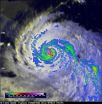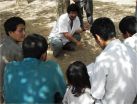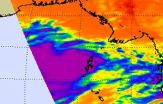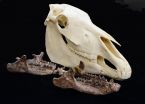Two NASA satellites get data on category 5 Super Typhoon Vongfong
2014-10-08
(Press-News.org) Two NASA satellites provided data on clouds, rainfall and the diameter of the eye of Super Typhoon Vongfong as it turned north in the Northwestern Pacific Ocean.
Typhoon Vongfong formed on October 2, 2014 southeast of Guam. Typhoon Phanfone, that recently pummeled Japan, formed near the same area in the western Pacific Ocean.
Vongfong had wind speeds of about 120 knots (138 mph) when the Tropical Rainfall Measuring Mission or TRMM satellite flew above the intensifying typhoon's eye on October 7, 2014 at 0800 UTC (4 a.m. EDT). TRMM's Precipitation Radar (PR) showed that powerful storms in Vongfong's eye wall were producing very heavy rainfall. TRMM's Microwave Imager (TMI) show that multiple rain bands spiraling into Vongfong were also dropping rain over a large area.
On Oct. 8 at 02:15 UTC (Oct. 7 at 10:15 p.m. EDT), the MODIS instrument aboard NASA's Terra satellite captured a visible image of Super Typhoon Vongfong's wide cloud extend and the storm's wide circular eye.
On Oct. 8 at 1500 UTC (11 a.m. EDT), Vongfong had maximum sustained winds near 145 knots (167 mph/268.5 kph) making it a Category 5 Super Typhoon on the Saffir-Simpson Scale. It was centered near 18.7 north and 130.7 east. It was centered about 510 nautical miles (586 miles/944.5 kph) south-southeast of Kadena Air Base, Okinawa, Japan. Vongfong was moving to the north at 7 knots (8 mph/13 kph). It was creating extremely rough seas in the Philippine Sea, with wave heights to 50 feet (15.2 meters).
According to the U.S. Kadena Airbase, on Oct. 8, a combined Japanese-U.S. Air Force rescue team recovered the body of the third Airman who had been swept out to sea on Oct. 5 from Typhoon Phanfone.
The Joint Typhoon Warning Center predicts that Vongfong is predicted to weaken slightly while moving toward the islands of southern Japan.
INFORMATION:
Rob Gutro/Hal Pierce
NASA's Goddard Space Flight Center
[Attachments] See images for this press release:


ELSE PRESS RELEASES FROM THIS DATE:
2014-10-08
WASHINGTON, DC – October 8, 2014 - Elephants are among the most intelligent non-humans, arguably on par with chimps, but both African and Asian elephants—separate species—are endangered. In 1995, 16-month old Kumari, the first Asian elephant born at the National Zoo in Washington, DC, died of a then-mysterious illness. In 1999, Gary Hayward of Johns Hopkins University and collaborators published their results identifying a novel herpesvirus, EEHV1 as the cause of Kumari's sudden death. They now show that severe cases like this one are caused by viruses ...
2014-10-08
ST. LOUIS, MO – OCTOBER 8, 2014 – What could the natural diversity and beauty of plant leaves have in common with one of mankind's greatest creative inventions, the violin? Much more than you might imagine.
"There are many parallels between leaves and violins," says Dan Chitwood, Ph.D., assistant member, Donald Danforth Plant Science Center in St. Louis, Missouri. "Both have beautiful shapes that are potentially functional, change over time, or result from mimicry. Shape is information that can tell us a story. Just as evolutionary changes in leaf shape inform ...
2014-10-08
Gamma rays are the highest-energy form of radioactive waves known in the universe. However, how they're made and where they come from have been a bit of a mystery.
But now a team of researchers, led by Michigan State University astronomer Laura Chomiuk, has made a discovery that may shed some light on the subject.
Using highly detailed radio telescope images, Chomiuk and her team have pinpointed the location where an explosion on the surface of a star, known as a nova, emitted gamma rays.
This, said Chomiuk, is something they did not expect to encounter.
"We not ...
2014-10-08
In western society, where keeping up with the Joneses — or, better yet, surpassing them — is expected and even encouraged, status matters. So important is it that for many people, physical and emotional wellbeing are directly connected to their place in the social hierarchy.
That's hardly news to anthropologists at UC Santa Barbara, but they were taken by surprise when research findings indicated that the same relationship exists among the Tsimane, an egalitarian society of forager-farmers in the Bolivian Amazon. Their work is published online in the journal ...
2014-10-08
The Northern Indian Ocean has awakened after a tropical slumber and created Tropical Storm Hudhud on Oct. 8 and NASA's Aqua satellite passed overhead.
The Atmospheric Infrared Sounder or AIRS instrument that flies aboard NASA's Aqua satellite passed over Tropical Cyclone Hudhud on Oct. 8 at 6:53 UTC (2:53 a.m. EDT and captured infrared data on the storm revealing bands of strong thunderstorms around the center.
Animated infrared satellite imagery showed that the low-level circulation center was consolidating, and there is an improvement in the banding of thunderstorms ...
2014-10-08
TORONTO, October 7, 2014 – Health technology company Infonaut, a MaRS client, has released a study showing that hospital patients may be at significant risk of infection due to their own poor hand hygiene. The findings were measured in a Toronto hospital using Infonaut's Hospital Watch Live™ system, innovative technology designed to assist hospitals in monitoring and controlling the spread of infections by analyzing the movement and behaviour of hospital staff, patients and equipment.
The study found that patients on average washed their hands only 30% of the time ...
2014-10-08
Researchers at Children's Hospital Los Angeles (CHLA) have described for the first time a specific perceptual learning deficit in mice with a mutation of the same gene as found in children with Fragile X Syndrome (FXS). Their findings, published on October 8 by PLOS ONE, may offer an effective pre-clinical platform for both investigating how brain circuitry is altered in FXS and testing drugs to improve these symptoms in children.
FXS is the most common inherited form of mental impairment, affecting an estimated 1 in 4,000 males and 1 in 6,000 females. Symptoms include ...
2014-10-08
Four families likely influenced violin shape over four centuries, with many imitating famous designs like Stradivarius, according to a study published October 8, 2014 in the open-access journal PLOS ONE by Daniel Chitwood from Donald Danforth Plant Science Center in Missouri.
The first violins appeared in 16th century Italy and since then, their designers have continued to incorporate numerous innovations to improve the acoustical properties and playability of violins. However, details of the body outline can vary without significantly compromising sound quality and may ...
2014-10-08
The discovery of new bones from a large land mammal that lived about 48 million years ago has led scientists to identify a new branch of mammals closely related to modern horses, rhinos, and tapirs, according to a study published October 8, 2014 in the open-access journal PLOS ONE by Lisa Noelle Cooper from Northeast Ohio Medical University and colleagues.
This family of large mammals, Anthracobunidae, is only known from India and Pakistan and was commonly considered to be ancestors of modern elephants and sea cows. Geographically, this was a puzzling idea, because elephants ...
2014-10-08
Healthier foods and beverages have been consistently more expensive than unhealthier ones from 2002-2012, with a gap that's growing, according to a study published October 8, 2014 in the open-access journal PLOS ONE by Nicholas Jones from University of Cambridge, UK, and colleagues.
Governments have identified access to affordable healthy diets as a key factor in improving public health, yet methods for tracking prices of more and less healthy foods over time have not been established. The authors of this study analyzed existing government data on national food prices ...
LAST 30 PRESS RELEASES:
[Press-News.org] Two NASA satellites get data on category 5 Super Typhoon Vongfong







